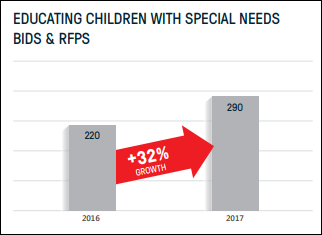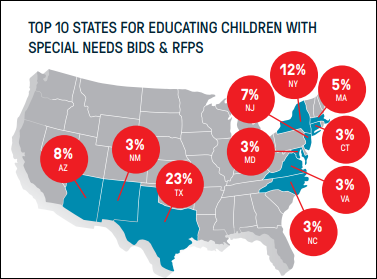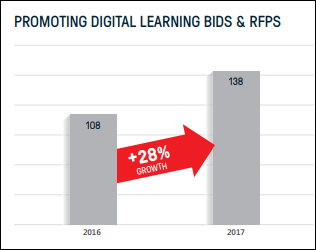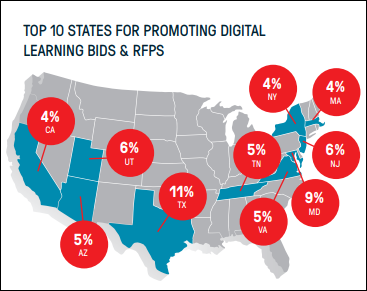Two ‘Hotspots’ in Education Procurement Identified for 2018
Procuring digital learning tools and technology to help educate students with special needs are two of 10 “hotspots” in government contracting for 2018, according to an analysis of bids and RFPs conducted by GovWin+Onvia from Deltek.
The market intelligence business found these two education priorities gaining momentum among its “top 10” areas of growth in the universe of $1.5 trillion spent annually in the state, local and educational government market. The company analyzed procurement documents using more than 4,000 unique industry tags to uncover the areas showing the greatest rates of percentage growth from 2016 to 2017 for its “10 Hotspots for Government Contracting in 2018” report.
The emerging availability of technology in education—like assistive devices designed for special needs students—and instructional technology in “digital learning” are part of the reason these areas have gained ground, said Paul Irby, the principal research analyst for the report. “Often, hotspots come about because of the need, and the politics that say, ‘We need to do something about this, and right now there are tools and technology available,” he said. Often more technology drives more demand.
In education, the fastest-growing segment was educating children with special needs, which jumped 32 percent. In an EdWeek Market Brief analysis of 2017 procurement trends where the Every Student Succeeds Act was mentioned, helping children with special needs ranked in the top five categories.

GovWin+Onvia is a partner in providing RFPs, bids and award information for the Purchasing Alerts that EdWeek Market Brief publishes twice each week. In 2017, some of those featured RFPs included the search for a case management system for all special education data in the Dallas, Texas district; while the Houston school system issued two tech-focused RFPs for a host of special education services, including assistive technology, instructional materials, and targeted professional development. And the Ohio education department’s Office of Fiscal Services was in the market for an analysis of data about pre-K special education outcomes.
The map below identifies the states that showed the most growth last year in procurement opportunities around helping children who have special education needs.

Meanwhile, promoting digital learning grew at a pace of 28 percent. This category included procurement documents for supplemental online education courses, including districts paying for students’ Advanced Placement courses, and credit recovery programs for students who have failed a course. As my colleague Ben Herold reported on the Digital Education blog, more than half of U.S. K-12 school districts have students enrolled in a total of 1.8 million distance-education courses, and 59 percent of districts reported having students enrolled in heavily internet-based courses.

Examples of RFPs in this category last year included three from states: Maryland’s search for blended learning courses for its Juvenile Education Services System, and the state of North Carolina’s search for a digital literacy curriculum to advance digital skills in low-income districts. In Texas, the state’s education agency sought math blended learning curricula. Nashville was in the market for an online credit recovery curriculum, and San Diego wanted a “one-stop shop” type of online learning system that included credit recovery courses and elective courses in career and technical education.
Highlighted on the map below are the states that showed the biggest gains in procurement for digital learning products.

In previous years, hotspots were STEM and 3D printing products, Irby said. Before that, Irby’s study of contracting driven by the then-new Common Core State Standards found uneven trends in different states, he said.
Besides education, hotspots for growth in government procurement included:
- “Flying drones,” in emerging areas like law enforcement, natural disaster response and making deliveries, which had 194 percent growth;
- Outsourcing smart fleet maintenance (at 40 percent growth);
- Providing continuous power, (at 39 percent growth);
- Increasing officer safety (also at 39 percent).
The full report is available free here.
Follow EdWeek Market Brief on Twitter @EdMarketBrief or connect with us on LinkedIn.
See also:
